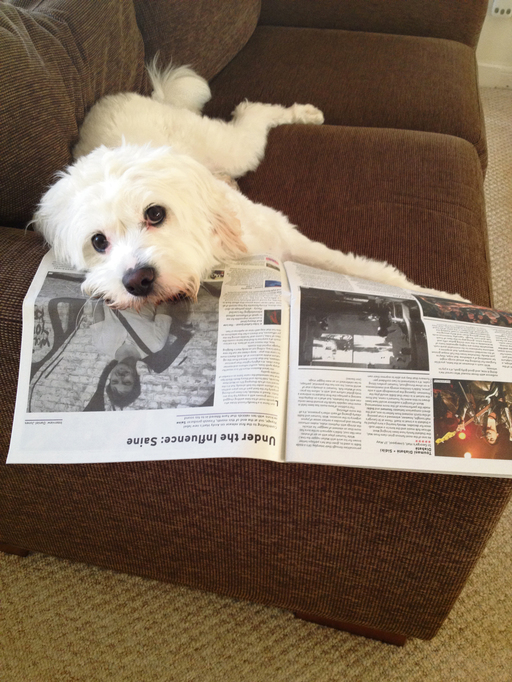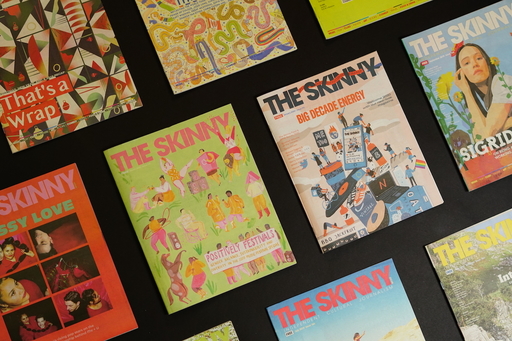Pitching To The Skinny
The Skinny is an independent cultural magazine based in Edinburgh, Scotland. We print a free monthly print edition, and distribute it through a venue network across Scotland. We also regularly publish web-only content through our website, and have the usual array of social media channels etc. We want to provide opportunities for new writers to showcase their work, so we've put this guide together to (hopefully) make our commissioning process as clear as possible.
The ideal article in The Skinny is...
-
Relevant to our Scotland-based audience: This doesn't mean 'no stuff from outside Scotland', but we want articles that will resonate with the people who read the magazine, and most of those people are based in Scotland. If you want to write about an exhibition in a London gallery, we're probably not the right folk for it; if you're talking about a London filmmaker whose films can be watched anywhere, that might work better. If you want to look at a TV show, everyone watches TV! It's about making sure there's some hook for the readership.
-
Timely: We make a monthly magazine, so naturally a lot of the content is time-sensitive and linked to events or releases within the lifespan of the print mag. If we're running a retrospective piece, it's probably tied into an anniversary – a 10th birthday, or 25 years since... etc etc.
On a topic we regularly cover: Read through the magazine, take a look at the website... if you think your idea could fit in amongst what you see, it's probably suitable.
-
Written by and/or covering an underrepresented voice: We want to support people, organisations, artists, groups, writers and issues that might not be seen in other media.
-
Interesting, insightful, funny, and/or challenging: We want engaging, exciting writing with a clear perspective or stance.
Not every article will need to hit all of these marks; don't see them as a checklist, more a guide to whether you're on the right track

What does The Skinny commission?
Features: Interviews, opinion pieces, retrospectives, and general feature writing. We commission these in all sections of the magazine, with word counts of between 700-1400w. We will sometimes go longer, but only in very specific circumstances.
Reviews: Books, Film & TV, Music and Art are the regular review sections in print, with additional reviews in those sections and others running online. 200-400 words, depending on the circumstances.
Anything else you see in print or online (news, track premieres, list/round-up articles, the back page Q+A, the newsletter etc) is produced by staff writers and isn’t commissioned out.

Your pitch: what you should (and shouldn't) include
-
A good subject line: Try to sum up the jist of your idea in that line so that when it hits our inbox, we say ‘ooooh’ and open the email. Use ‘pitch’, 'Article pitch', 'Feature pitch' etc in the subject line, so we know that it's a pitch.
-
Outline your idea: What do you want to write? Who will you talk to? What is the broad direction you want to head in with this piece? We don’t want the whole piece at this stage, but a few sentences outlining your plan are hugely helpful.
-
Fill in some of the blanks: Who are you? What are your interests, background, credentials for talking about the topic? If you want to interview a particular person, do you already have a way of getting in touch? If it’s an opinion piece, what sparked your desire to write it? Do you have writing samples (published or unpublished) that we can see, to get a sense of your style and tone?
-
What’s the hook?: Is this a story everyone else is missing? Is there a perspective you can bring which is missing from the conversation? Why does this story deserve all of our attention? What makes this pitch particularly relevant, and why should we publish this piece now?
-
Keep it brief: Two or three paragraphs is an ideal pitch length; don’t go over 200 words. A pitch should be an outline of the proposed story, and an idea of where you’ll take it once you’re commissioned – think of it as the start of a conversation, not a full monologue.
Don’t send full articles on spec: We want to work with you to make your writing as strong as possible, and that means giving us the chance to do so. It’s much easier to make changes to an article at an early stage, so we ask that you send a pitch rather than the whole piece.

Sending Us A Pitch
Once your pitch is ready to go, send it to pitches@theskinny.co.uk and/or the relevant section editor.
We're checking that inbox regularly, so it's a good first port of call particularly if you don't already have a relationship built up with an editor. If your pitch is particularly time-sensitive, a follow-up email after a week or so is a good way of bumping a pitch up the inbox.
Our section editors have commissioning responsibility within their sections of the magazine; a look through the monthly magazine will give you an idea of roughly how much content they’re looking to commission in a given month, and a sense of their favoured topics and tone. You can find their contact details here. A lot of our section editors are freelance, and the rest are staffers with other tasks besides commissioning, so you might not get a reply straight away.
There’s also a separate (but smaller) pot for web commissioning, which is handled by our Digital Editor Peter working alongside those section editors; this can be more ad-hoc, so it’s worth cc’ing Peter in on pitches if they’re specifically for the website or fall outside the print timeframe.
We aim to reply to everyone, but ultimately we may not respond to every unsolicited pitch. Our budgets and time are limited and we simply cannot take on every single pitch. One of your ideas might not be suitable, but the next might be right up our street, so don’t be disheartened by a pitch rejection.
If you're new to The Skinny and want more detail on what we publish and who's in charge, go to Content Guide and Contact List
For info on the timescales we work to and the rates we pay, go to Deadlines, Timeframes and Payments
If this is all seems a bit vague and hypothetical and you want some real-world examples, go to Sample Pitches, And Why They Worked